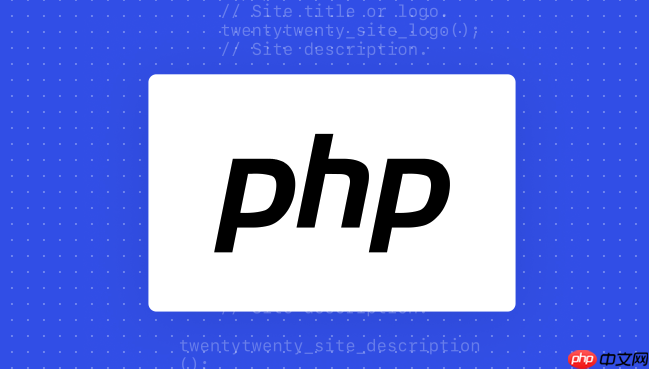PHP中替换字符串的核心函数是str_replace()和preg_replace(),前者用于固定文本替换,效率高;后者基于正则表达式,适用于复杂模式匹配。根据需求选择:简单替换用str_replace(),复杂模式用preg_replace()。性能敏感场景优先使用str_replace(),因其无正则解析开销。实际应用包括数据清洗(如去特殊字符、防XSS)和模板渲染(如占位符替换)。对于仅替换首个匹配项,可用preg_replace()的limit参数或结合strpos()与substr_replace()实现。

PHP里要替换字符串的一部分,核心就是用
str_replace()
preg_replace()
str_replace()
preg_replace()
我个人觉得,写PHP代码这么多年,字符串操作是绕不开的坎儿。尤其是替换,看似简单,但背后门道还真不少。很多时候,我们只是想把某个词换成另一个,
str_replace()
preg_replace()
1. str_replace()
这是最常用、也最容易理解的函数。它的作用就是在一个字符串中,把所有出现的指定文本替换成另一个文本。
立即学习“PHP免费学习笔记(深入)”;
// 基本用法:替换单个字符串
$text = "Hello, world! Hello PHP!";
$newText = str_replace("Hello", "Hi", $text);
echo $newText; // 输出: Hi, world! Hi PHP!
// 替换多个不同的字符串
$text = "Apple, Banana, Orange";
$search = ["Apple", "Banana"];
$replace = ["Pineapple", "Grape"];
$newText = str_replace($search, $replace, $text);
echo $newText; // 输出: Pineapple, Grape, Orange
// 如果替换字符串少于查找字符串,多余的查找字符串会被替换为空
$text = "Red, Green, Blue";
$search = ["Red", "Green", "Blue"];
$replace = ["Black", "White"];
$newText = str_replace($search, $replace, $text);
echo $newText; // 输出: Black, White,
// 统计替换次数 (可选的第四个参数)
$text = "one two one three one";
$count = 0;
$newText = str_replace("one", "four", $text, $count);
echo $newText . "\n"; // 输出: four two four three four
echo "替换次数: " . $count; // 输出: 替换次数: 3
// 不区分大小写的替换:str_ireplace()
$text = "Hello World";
$newText = str_ireplace("hello", "Hi", $text);
echo $newText; // 输出: Hi Worldstr_replace()
2. preg_replace()
当你的查找条件不是一个固定的字符串,而是一个模式(pattern)时,
preg_replace()
// 基本用法:替换所有数字
$text = "My phone number is 123-456-7890 and my age is 30.";
$newText = preg_replace('/\d+/', '[NUMBER]', $text);
echo $newText; // 输出: My phone number is [NUMBER]-[NUMBER]-[NUMBER] and my age is [NUMBER].
// 替换HTML标签(简单示例,不推荐用于复杂HTML解析)
$html = "<p>Hello <b>world</b>!</p>";
$newHtml = preg_replace('/<[^>]+>/', '', $html);
echo $newHtml; // 输出: Hello world!
// 使用捕获组和反向引用:提取并重组
$text = "Name: John Doe, Age: 30";
// 匹配 "Name: (任意字符), Age: (任意数字)"
$pattern = '/Name: (.*?), Age: (\d+)/';
// 替换为 "User (John Doe) is (30) years old."
$replacement = 'User ($1) is ($2) years old.';
$newText = preg_replace($pattern, $replacement, $text);
echo $newText; // 输出: User (John Doe) is (30) years old.
// 不区分大小写 (使用 'i' 修饰符)
$text = "PHP is fun, php is great.";
$newText = preg_replace('/php/i', 'Python', $text);
echo $newText; // 输出: Python is fun, Python is great.
// 限制替换次数 (可选的第四个参数)
$text = "apple banana apple orange apple";
$count = 0;
$newText = preg_replace('/apple/', 'grape', $text, 2, $count); // 只替换前2个
echo $newText . "\n"; // 输出: grape banana grape orange apple
echo "替换次数: " . $count; // 输出: 替换次数: 2preg_replace()
str_replace()
3. substr_replace()
如果你的需求是替换字符串中某个特定位置到另一个特定位置的字符,而不是基于内容查找,那么
substr_replace()
$text = "The quick brown fox."; // 从第4个字符开始,替换5个字符 $newText = substr_replace($text, "slow", 4, 5); echo $newText; // 输出: The slow brown fox. // 替换到字符串末尾 (长度参数为0或省略) $newText = substr_replace($text, "cat", 16); // 从第16个字符开始替换到末尾 echo $newText; // 输出: The quick brown cat. // 插入字符 (长度参数为0) $newText = substr_replace($text, "very ", 4, 0); echo $newText; // 输出: The very quick brown fox.
substr_replace()
说到底,这三种工具各有侧重。
str_replace
preg_replace
substr_replace
这确实是个常见的需求,尤其是在处理日志或者解析特定格式数据时。
str_replace()
preg_replace()
limit
方法一:使用 preg_replace()
limit
这是最直接也最推荐的方式,因为它简洁明了。
preg_replace()
limit
$text = "apple banana apple orange apple";
// 只替换第一个 'apple'
$newText = preg_replace('/apple/', 'grape', $text, 1);
echo $newText; // 输出: grape banana apple orange apple这里,
1
2
方法二:结合 strpos()
substr_replace()
如果你坚持不用正则表达式,或者只是替换一个固定字符串的第一个匹配项,那么可以手动找到第一个匹配的位置,然后用
substr_replace()
$text = "apple banana apple orange apple";
$search = "apple";
$replace = "grape";
// 查找第一个匹配项的位置
$pos = strpos($text, $search);
if ($pos !== false) {
// 如果找到了,就用 substr_replace 进行替换
$newText = substr_replace($text, $replace, $pos, strlen($search));
echo $newText; // 输出: grape banana apple orange apple
} else {
echo "未找到匹配项。\n";
echo $text; // 输出: apple banana apple orange apple
}这种方法稍微复杂一点,需要先用
strpos()
substr_replace()
preg_replace()
这确实是一个值得深思的问题,尤其是在处理大量数据或者高并发请求时。虽然对于小规模、低频率的操作,两者的性能差异几乎可以忽略不计,但了解它们的底层机制和性能特点,能帮助我们做出更明智的选择。
性能差异:
str_replace()
str_replace()
preg_replace()
preg_replace()
选择考量:
需求复杂度:
str_replace()
"foo"
"bar"
preg_replace()
性能敏感度:
str_replace()
preg_replace()
preg_replace()
preg_replace
代码可读性和维护性:
str_replace()
preg_replace()
总结一下,我的经验是:能用
str_replace()
preg_replace()
preg_replace()
字符串替换在PHP的日常开发中,特别是在数据清洗(Data Sanitization)和模板渲染(Template Rendering)这两个领域,简直是无处不在的核心操作。它们是构建健壮、安全和动态Web应用的基础。
1. 数据清洗(Data Sanitization)
数据清洗的目标是确保输入的数据是安全、有效且符合预期的。字符串替换在这里扮演着关键角色,用于去除恶意内容、格式化数据或进行编码。
去除不必要的字符: 用户输入常常会包含一些我们不希望出现在数据库或显示页面的字符,比如额外的空格、特殊符号甚至是一些控制字符。
// 去除字符串两端和中间多余的空格
$input = " Hello World! ";
$cleanedInput = preg_replace('/\s+/', ' ', trim($input));
echo $cleanedInput; // 输出: Hello World!
// 移除数字以外的所有字符
$phone = "Call me at +1 (555) 123-4567";
$digitsOnly = preg_replace('/[^0-9]/', '', $phone);
echo $digitsOnly; // 输出: 15551234567HTML标签过滤/转义: 防止XSS(跨站脚本攻击)是数据清洗的重中之重。虽然PHP有
strip_tags()
htmlspecialchars()
// 移除所有HTML标签 (类似 strip_tags,但可以自定义更复杂的规则)
$comment = "<script>alert('XSS');</script><b>Hello</b> world!";
$safeComment = preg_replace('/<script\b[^>]*>(.*?)<\/script>/is', '', $comment); // 移除script标签
$safeComment = strip_tags($safeComment, '<b><i>'); // 允许粗体和斜体
echo $safeComment; // 输出: <b>Hello</b> world!
// 替换特殊字符为HTML实体 (如果不用 htmlspecialchars)
$text = "This has < and > characters.";
$htmlSafe = str_replace(['<', '>'], ['<', '>'], $text);
echo $htmlSafe; // 输出: This has < and > characters.URL参数清理: 有时URL参数中可能包含不安全的字符或需要编码的部分。
$urlParam = "user name with spaces & special chars?";
$encodedParam = urlencode($urlParam); // 这是更推荐的方式,但如果需要手动替换
// 或者,用 str_replace 替换空格为 %20 (不推荐手动实现完整的URL编码)
$manualEncoded = str_replace(' ', '%20', $urlParam);
echo $manualEncoded; // 输出: user%20name%20with%20spaces%20&%20special%20chars?2. 模板渲染(Template Rendering)
模板渲染是将动态数据填充到预定义的模板结构中的过程。字符串替换是实现简单模板引擎的核心机制。
占位符替换: 这是最常见的应用。模板中定义一些特殊的占位符(如
{{name}}[MESSAGE]
$template = "<h1>Welcome, {{username}}!</h1><p>Your last login was on {{last_login}}.</p>";
$data = [
'username' => 'Alice',
'last_login' => '2023-10-26 10:30:00'
];
// 简单替换占位符
$output = str_replace(
array_map(fn($key) => '{{' . $key . '}}', array_keys($data)),
array_values($data),
$template
);
echo $output;
// 输出: <h1>Welcome, Alice!</h1><p>Your last login was on 2023-10-26 10:30:00.</p>动态内容生成: 根据条件或数据生成不同的内容片段。
$template = "Items: [ITEMS_LIST]";
$items = ['Apple', 'Banana', 'Orange'];
$itemsHtml = '';
foreach ($items as $item) {
$itemsHtml .= "<li>{$item}</li>";
}
$output = str_replace('[ITEMS_LIST]', "<ul>{$itemsHtml}</ul>", $template);
echo $output;
// 输出: Items: <ul><li>Apple</li><li>Banana</li><li>Orange</li></ul>URL重写或美化: 虽然通常由Web服务器(如Apache的mod_rewrite或Nginx)处理,但有时在PHP内部也需要对URL进行一些替换操作。
$oldUrl = "/index.php?page=about&id=123"; $newUrl = str_replace(['/index.php?page=', '&id='], ['/about/', '/'], $oldUrl); echo $newUrl; // 输出: /about/123
当然,对于复杂的模板系统,通常会使用专门的模板引擎(如Twig、Blade等),它们提供了更强大的语法、缓存机制和安全性。但这些高级引擎的底层,依然离不开大量的字符串处理和替换操作。理解这些基本原理,对于我们使用和优化这些工具都是非常有帮助的。
以上就是php如何替换字符串中的一部分?php字符串查找与替换操作的详细内容,更多请关注php中文网其它相关文章!

PHP怎么学习?PHP怎么入门?PHP在哪学?PHP怎么学才快?不用担心,这里为大家提供了PHP速学教程(入门到精通),有需要的小伙伴保存下载就能学习啦!

Copyright 2014-2025 https://www.php.cn/ All Rights Reserved | php.cn | 湘ICP备2023035733号